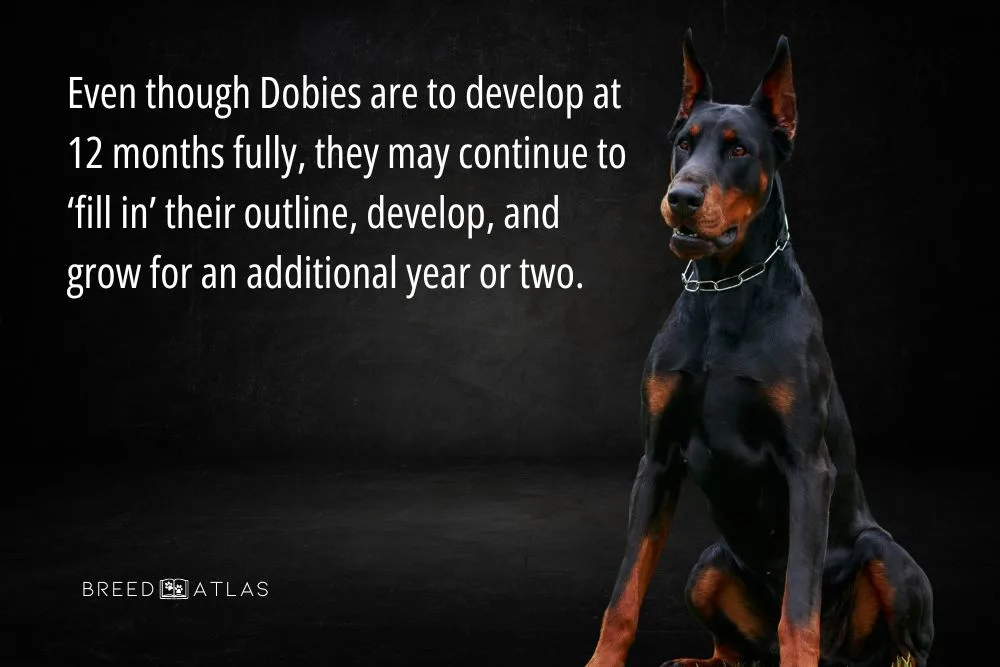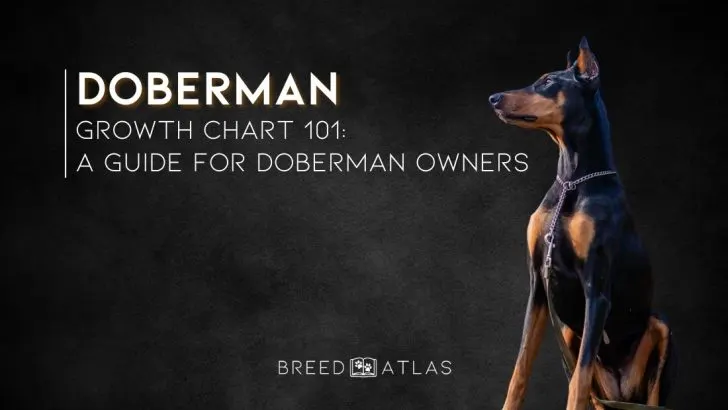The Dobie, or the Doberman Pinscher, is a noble and well-respected dog breed. Louis Dobermann knew what he was up to! The standard Doberman is a well-known breed for being devoted, protective family pets and guard dogs.
With these growth charts, owners can follow the Doberman growth chart and development from puppyhood to adulthood. Along the growth charts, you will be presented with some general characteristics of this dog breed that future owners should find useful.
These muscular, elegant dogs have a tough reputation that every single Doberman owner can prove wrong. Yes, they make great security dogs, but they will also be your dearest and goofiest sidekicks.
Despite their big size and striking looks, these pups are kind, lively, incredibly affectionate, and sensitive. Dobermans are among the most preferred breeds in the US and have continuously been among the top 20.
The average Doberman weight is sixty to one hundred pounds, proving the ‘accusations’ of being a large dog true.
In this article, I’ll focus on the first two years of your dog’s growth and development, cover the most typical stages of adult Dobermans and their needs, and discuss growth-influencing factors.
Two Major Milestones In Your Doberman’s Growth Phases
Reaching the healthy and expected growth standards for male and female Dobermans takes a lot of work, healthy and regular meals, and exercise to gain muscle mass.
Therefore, take a look at the most simple Doberman growth phases divided into two major milestones:
| Phase | Age | Changes |
| 1st Phase | 0 – 12 months | In the first stage, your Doberman will grow to its full height. Now, they are young adults, whose bones and muscles have lengthened, however, they have not reached their full body weight and muscle mass. It often happens that during the 1st phase, your Doberman might show a kind of discomfort due to growing. |
| 2nd Phase | 12 – 24 months | Entering the 2nd phase, which is the 2nd year of your Doberman’s life, your puppy will be done growing in terms of height. However, they will gain some weight, especially if your Doberman is a male. Male Dobermans tend to gain much more muscle mass if exercised regularly and fed properly. You’ll notice that in the 2nd phase, your Doberman will become ‘wider’, in the sense that its chest will become broader and more powerful, its necks ticker, shoulders more defined. |
One thing worth mentioning regarding these two phases is that the 2nd phase is far more visible in the European Doberman variety since European Dobermans are known for being a bit on the bulkier side than the American Dobermans.
Yes, the American Doberman will also ‘fill out’ its frame, getting on more muscle mass and definition, however, far less than the European one who has an increased size, per say.
Doberman Growth Chart (Weight By The Month)
Covering the first 18 months of your pup’s life, this chart will show you the usual Doberman growth chart for the 1st phase and a half of the second phase.
Below, you will see a chart showing the months of age of your puppy, in accordance with the gender, showing you the minimal and maximal average weight your puppy should be at a certain age, which is a rough estimate.
Mind you, these are approximate. Therefore, they can vary from one pup to another.
| Age | Male Weight (Min – Max) | Female Weight (Min – Max) |
|---|---|---|
| 1 Month | 9 – 18 lbs | 8 – 15 lbs |
| 2 Months | 18 – 21 lbs | 15 – 19 lbs |
| 3 Months | 26 – 32 lbs | 21 – 30 lbs |
| 4 Months | 35 – 44 lbs | 29 – 40 lbs |
| 5 Months | 44 – 54 lbs | 36 – 50 lbs |
| 6 Months | 50 – 64 lbs | 41 – 59 lbs |
| 7 Months | 59 – 71 lbs | 48 – 65 lbs |
| 8 Months | 61 – 79 lbs | 50 – 71 lbs |
| 9 Months | 66 – 85 lbs | 52 – 78 lbs |
| 10 Months | 69 – 89 lbs | 56 – 80 lbs |
| 11 Months | 70 – 91 lbs | 58 – 83 lbs |
| 12 Months | 71 – 94 lbs | 59 – 85 lbs |
| 13 Months | 72 – 98 lbs | 59 – 88 lbs |
| 14 Months | 74 – 98 lbs | 60 – 89 lbs |
| 15 Months | 75 – 99 lbs | 60 – 90 lbs |
| 16 Months | 75 – 100 lbs | 60 – 90 lbs |
| 17 Months | 75 – 100 lbs | 60 – 90 lbs |
| 18 Months | 75 – 100 lbs | 60 – 90 lbs |
The average growth rate of a Doberman Pinscher, expressed in pounds, is displayed on this growth chart. The chart’s foundation is the American Kennel Club’s (AKC) Doberman Breed Standard.
The graph above shows that the Doberman’s ideal weight after its first birthday is rather substantial. Doberman continues to acquire weight, but after a year, is deemed an adult and at full height.
Use this chart as a general reference for what to anticipate as your Doberman matures. The weight of Dobermans fluctuates widely, so it should only be regarded as an approximate approximation. It doesn’t always follow that your dog is sick if, at any particular stage, they are outside of the area of this chart.
Male Doberman Pinscher Height
The average height of male Doberman puppies from birth to age three is shown in the following chart. Note that these are merely averages. Consult a qualified veterinarian if you are worried about your Doberman’s growth.
The maximum height is always at its peak with male Dobermans. Sometimes, people might confuse a male with a female Doberman when they are not side to side – saying that the dog is smaller or bigger for its average size.
Therefore, here is an average chart for the reference:
| Age | Height (in inches) |
|---|---|
| Newborn | 4 – 6 |
| 1 Month | 7 – 9 |
| 2 Months | 10 – 12 |
| 3 Months | 14 – 17 |
| 4 Months | 18 – 21 |
| 5 Months | 21 – 24 |
| 6 Months | 23 – 26 |
| 9 Months | 25 – 28 |
| 12 Months | 26 – 29 |
| Two Years | 27 – 30 |
| Three Years | 27 – 31 |
Female Doberman Pinscher Height
The following chart contains the average heights of a female Doberman from newborn to 3 years of age. Please note these are only averages. Always consult your veterinarian if you have any concerns about your Doberman’s growth.
This is an essential step in your dog’s health, and assessing if there are needs for any veterinary treatments, or exams.
| Age | Height (in inches) |
|---|---|
| Newborn | 4 – 6 |
| 1 Month | 6 – 8 |
| 2 Months | 9 – 11 |
| 3 Months | 12 – 15 |
| 4 Months | 16 – 19 |
| 5 Months | 18 – 21 |
| 6 Months | 20 – 23 |
| 9 Months | 22 – 25 |
| 12 Months | 23 – 26 |
| Two Years | 24 – 27 |
| Three Years | 24 – 28 |
Please keep in mind that female Dobermans are a bit more fragile regarding the bone structure, meaning they will look smaller than their male counterparts.
Timeline For Doberman Puppy Growth

I’ll review some of the crucial topics owners should be aware of when caring for a Doberman puppy in the following phases.
Puppies grow quickly, so keep a close eye on them as they go through each month’s stages of growth and development. It’s important to note that Doberman puppies require more time to reach their full growth than puppies from other breeds.
Even though they are to develop at 12 months fully, they may continue to ‘fill in’ their outline, develop, and grow for an additional year or two.
From A Newborn to a Two-week-old
Dobie puppies weigh between ten and twenty ounces when they are born, which is extremely small – just like any other puppy. They cannot see or hear anything because they are born with closed eyes and ears.
At this period, they rely entirely on their mother for their needs. They will nurse her often and remain really close to her. Encouraging and permitting puppies to nurse for as long as required is best.
It’s crucial to consult your regular veterinary care provider as soon as possible to choose a suitable puppy milk alternative if it appears that they aren’t getting enough food.
If the decision is taken to dock the puppy’s tail, it should happen around the time it is five days old. While docked tails and trimmed ears are hallmarks of the conventional Doberman appearance, not all breeders or owners will opt for this look.
With this breed, the American Kennel Club standard states that the tail should be docked at about the second joint, which is a contentious issue.
But breed standards specify that the tail should be left naturally and held high with a small curve in other parts of the world, such as the Americas, Asia, Africa, and the Caribbean.
One Month Old Doberman
Your Doberman puppy will no longer be as little and fragile after one month. Puppies, both male and female, will weigh five to ten pounds.
By now, they ought to have developed some degree of motor control, and their eyes and ears should be fully awake. Puppies will begin to crawl and move around in order to investigate their surroundings. Your dog’s personality will start to come through in one month.
Additionally, this is a wonderful time to begin weaning preparations. Although they can now be given puppy mush, puppies will still need to be nursed. They can begin to be given food that has been soaked in water or puppy formula.
Puppies will nurse less as they become increasingly interested in this food.
They will begin to regain greater control over their abilities, such as going potty by themselves. It’s time to begin the deworming procedure if they haven’t seen a veterinarian yet. This is the time when they should be on their first or second dose.
Two Month Old Doberman
When pups are two months old, they become very active. They are more secure when walking and eager to play and explore. Puppies will go from nursing to eating exclusively puppy food during this crucial second month.
They might show some reluctance to spend less time with their mother. She is, however, ready for them to stop nursing since they require more nutrition to support their fast growth than formula can provide.
Male Doberman puppies that are two months old will weigh between fifteen and twenty pounds, while female puppies weigh between ten and twenty pounds.
Recall that during this period of fast growth, this breed gains approximately 10 pounds every month. That is the so-called ‘rule of thumb,’ which is a general rule saying that the Doberman puppy should gain 10 pounds a month in this period of puppyhood.
This rule continues until the puppy turns a year old and reaches its adult height.
They will require plenty of calories, high-quality protein, and lots of relaxation to sustain their rapid growth. If ear cropping is to be done, it should be planned for seven to nine weeks. It’s time to start getting ready and introducing your dog to house training.
Three Month Old Doberman

By now, a three-month-old Doberman puppy is a sizeable dog. The weight range for males is 25–35 pounds, while the weight range for girls is 20–30 lbs.
At this point, they ought to have planned or begun with vaccines. If you haven’t started training yet, now is the perfect moment. Dobermans can be pretty large by now, and accidents can be very unpleasant, so house training is especially crucial.
It is essential that the Doberman Pinscher be house trained, provide encouragement and praise wherever possible.
Your veterinarian will want to administer rabies and other vaccinations at this time. Teething also commences during this time. Adult teeth will erupt and replace baby teeth. It’s crucial to teach them not to bite people or other animals and to give them the proper teething toys.
Puppies should only eat premium puppy kibble—ideally a large breed of dog food—with the addition of fresh or wet food for flavor. Investing in quality dog food is better to avoid any medical risks.
Four Month Old Doberman
Despite having a full-size dog’s appearance, they are still developing and quite immature emotionally. At this stage, it’s crucial to make sure you’re focusing on socializing your puppy.
Dobermans might resemble skinny teenagers who cannot manage their bodies since they grow so large so soon. You’ll see these larger paws attached to a small body. They’ll grow into them, but at this point, it will be just too cute.
Training is essential for a dog as large as the Doberman, a highly energetic and protective breed.
Puppies must know how to interact with strangers, other dogs, and people in social settings. Training will take a lot of work, and you may not see results immediately, but keep going. Showing and teaching a puppy acceptable behavior now is far simpler than it will be later on.
Five Month Old Doberman
Your puppy requires three meals daily, with a nutrient-rich, balanced diet. Nutrition is crucial since these dogs will be extremely active, large, and growing rapidly.
They must replenish all of the energy they are using. Remain patient with your dog and keep up the training as much as possible. Though accidents could happen occasionally, potty training ought to be quite well established by this point.
Recall that puppies can be quite irritable, occasionally resulting in accidents. Even though your dog is larger than many adult small dogs, it’s vital to remember that they are still quite young.
Six Months Old Doberman
They now require a balanced mix of both exercise and rest. Even though it could appear like they have endless energy and want to play all day, Doberman owners must be cautious not to over-exhaust them.
Particularly for a large breed like the Doberman, ensure they don’t overexercise given their rapid growth. It may stunt their growth and increase their risk of developing hip dysplasia and other problems.
Although your puppy’s bodily size is still developing, his internal organs will be almost fully developed. It’s time to talk about getting your dog neutered or spayed if you haven’t already.
Puberty and excess hormones usually start to show around six months. Your dog’s behavior may start to change due to these hormonal shifts. This teenage behavior includes marking territory, spraying, and attempting to mount furniture and other dogs.
Nine Month Old Doberman
You might not notice the massive weight gain as much while they are still growing. Don’t forget to keep rewarding positive conduct. Even if your dog can seem to be completely trained, it’s crucial to reinforce the rules and training consistently.
Dogs, particularly this sensitive and perceptive breed, will begin to push boundaries. They will require daily physical activity in large quantities. Ensure dogs receive at least one or two long walks each day.
Along with many dog toys, they should have plenty of time to run around unrestricted.
One Year Old Doberman
Time to make the whole transition to adult meals. There will be further growth for the following two years. Dogs will still require daily active time, human interaction, and lots of exercise.
Maintain your dog’s regular diet routine. Certain dogs would rather eat just twice a day.
If you eat twice a day, the meals will be larger. You can split the same quantity of food into three meals rather than two if your dog finds eating three better.
Fully Grown Doberman

Dobermans will slightly grow out throughout the following few months to a year. The weights of males and females at 24 months will be 75–100 pounds and 60–90 pounds.
They will be between 24 and 28 inches tall when they reach full growth. The estimated weights show that adult male Dobermans are noticeably bigger than adult females. Now, their paw size is proportional to their body.
Throughout their lives, make sure your dog receives the recommended medical attention and immunizations. Adult dogs still require routine preventative care appointments, even though they will see the vet more frequently as puppies. These have a large impact on their health.
No more sudden changes in your dog’s growth will occur at this stage. Other than that, now you have a full-grown jogging buddy! Being larger dogs as they are, they will need regular activity. An active Doberman is a healthy Doberman!
European Doberman vs. American Doberman Weight And Height
There are some size and physical differences between American and European Dobermans.
Many people are unaware of the difference between the two dogs, even though it is obvious when they are side by side.
These distinctions between the American and European kinds largely determine the adult size you can expect.
Compared to their European counterparts, American Dobies appear smaller, sleek, and toned because most were bred as household pets. They are the ideal partners for outdoor training because of their toned and agile appearance.
American Doberman lines often have adult males who weigh between 75 and 100 pounds and measure 26 or 28 inches tall.
American Doberman lines often have adult females who weigh between 60 and 80 pounds and measure 24 or 26 inches tall.
While it is not as prevalent as for dogs descended from European lines, certain American dogs can go above these sizes.
Additional Remarks To Consider
A Doberman’s size can vary depending on several things. A lot depends on bloodline, genetics, and breed. Care, workout intensity, and nutrition will all equally matter.
Although these and other growth charts and guidelines are an excellent way for dog owners to monitor their pet’s development and milestones, they are not precisely indicators of a dog’s future size.
Your Doberman’s Health
Just as any other purebred dogs, Dobermans are more prone than other breeds to experience specific health issues. Although dilated cardiomyopathy is the most prevalent problem, this breed is susceptible to other cardiac diseases.
It is never a good idea to neglect this illness since it might result in heart failure and even abrupt death. Frequent examinations by veterinarians can aid in detecting major issues like cardiac illness. However, all these health conditions remain common health issues in dogs.
Another prevalent ailment that affects large breeds is hip dysplasia. The hip joint is prone to visible wear and strain because it grows unevenly and more quickly in some areas than others. Dogs with this ailment also experience significant pain.
Therefore, I would recommend requiring DNA testing from your breeder. Following the general guidelines about your dog’s health might help detect and prevent some health conditions early.
Spay And Neuter
Having this surgery done too soon can have long-term health effects. On the other hand, if you wait too long, your dog may develop health issues and have a more painful experience.
This surgery should occur between 6 and 11 months early for male Dobermans, just before the Doberman reaches its first birthday.
It is recommended, nevertheless, that females hold off until they are two years old, or at the very least, eleven months after they go into heat for the first time.
Waiting longer for females than males is a better idea since spaying female dogs earlier may put them at a higher risk of incontinence.
To Conclude
A grasp of the Doberman growth chart certainly made you feel more confident about your knowledge of Dobbie’s general guidelines.
Remember that your Doberman, American or European, will require constant care and attention. Active dogs need training, a balanced diet, and regular veterinary care.
Keep in mind that the American Doberman is smaller in size than the American Doberman. Also, female Dobermans usually are a bit shorter and tinier than their male counterparts. If you see some unusual overgrowth or undergrowth of your Doberman, visit your veterinarian.

Meet Iram, a devoted veterinarian, passionate dog lover, and current Ph.D. candidate at Utrecht University in the Netherlands. Seamlessly blending her roles as a vet and content writer, Iram channels her love for dogs into heartfelt narratives.
Since childhood, Iram nurtured a dream of becoming a vet, a passion that runs deep in her family. Having now fulfilled that dream, she’s eager to share her acquired knowledge. In her writing, Iram not only explores the emotional bond between humans and their canine friends but also integrates her veterinary expertise, offering readers a holistic understanding of their beloved pets.
